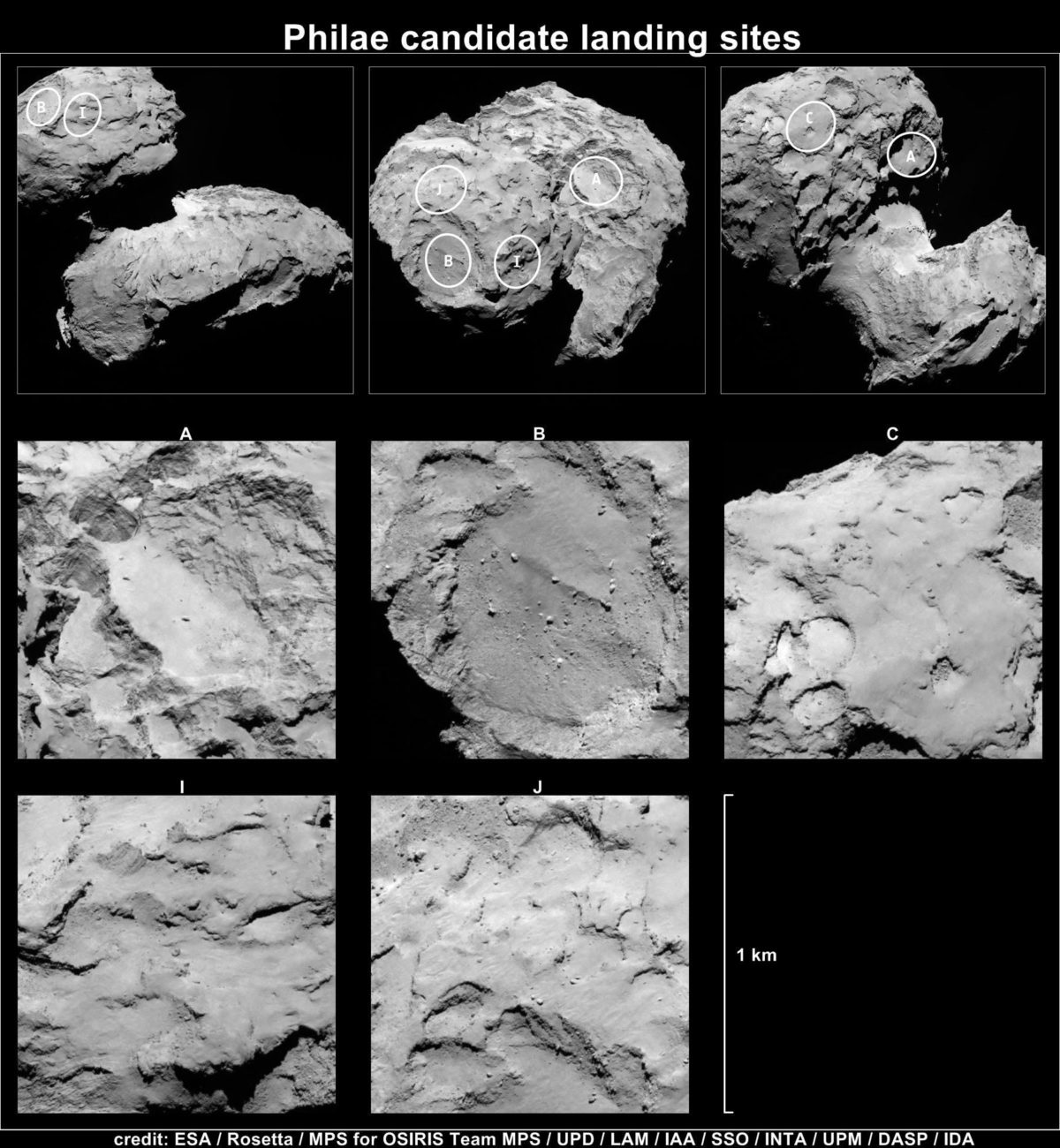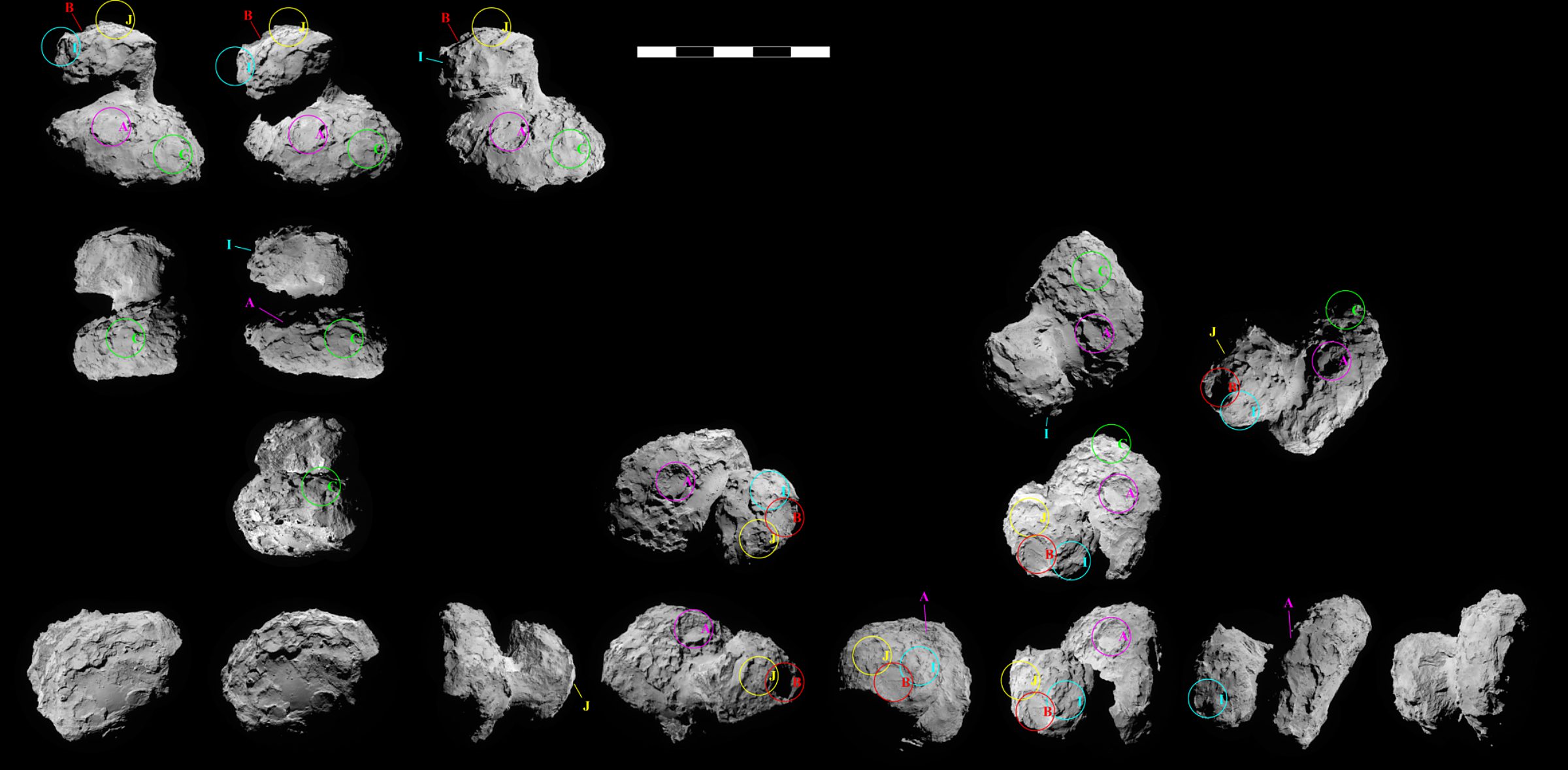Emily Lakdawalla • Aug 26, 2014
Rosetta identifies five possible landing sites for Philae
The Rosetta team has announced the selection of five regions on Churyumov-Gerasimenko that they will study as possible landing sites for little Philae. Two of the possible five are on the larger lobe of the comet, and three are on the smaller lobe. Now, as Rosetta surveys the comet from its second triangular "orbit" at an average distance of 60 kilometers, the mission will target these spots for extra attention. They'll examine the sites at closer and closer range over the coming weeks. They particularly need to know how rough the surface is at the scale of the lander, and to understand how local topography relates to the odd gravity field on this little world. They have to work fast; their goal is to identify a primary landing site by September 14.
Here are the views of the landing sites that ESA released, both regional ones identifying the locations of the sites, and more close-up ones of the individual sites. Thanks to Gerald Eichstädt for assembling these into an easy-to-digest single image:

The close-up images are from OSIRIS, the first such photos released since a 3D view released on the 14th. However, unlike the 3D view, these photos of the landing sites don't represent the full capability of the OSIRIS camera; they are small 540-pixel-square images cropped from the full 2048-pixel-square detector.
I found another image on the CNES website that shows a shape model of the comet, and all the sites marked:
I wanted to take a look at these sites in more detail, so I piled together all the NavCam photos that they have released from August 5 to today. I resized them all to a common scale of 5 meters per pixel, and tried to group them together according to their geometry. Then I dropped in circles atop the landing sites. All the circles are 1 kilometer in diameter, the approximate stated size of the Philae landing ellipse. Please don't take this map as gospel -- it's not a European Space Agency product, it's just my best effort at plotting the site locations on the released NavCam images.

Here are more detailed descriptions of each site, consisting of text edited from a combination of the ESA press release and the DLR press release:
Site A is located in an interesting region on the larger comet lobe, which allows a view of the smaller comet lobe. The narrow area between these two parts is probably already active as the comet begins its journey closer to the Sun. Images with increasing resolution will now allow more detailed investigations to assess the risks posed by small depressions and slopes on this landing site. The illumination conditions also need to be analysed in more detail.
Site B, within the crater-like structure on the smaller lobe, has a flat terrain and is thus considered relatively safe for landing, but illumination conditions may pose a problem when considering the longer-term science planning of Philae. Higher-resolution imaging will be needed to assess the boulder hazards in more detail. In addition, the boulders are also thought to represent more recently processed material and therefore this site may not be as pristine as some of the others.
Site C lies on the larger lobe of the comet. Here, scientists have found a range of different landforms such as depressions, cliffs, hills and flat areas – and also material that appears brighter than usual on the acquired images and is thus particularly interesting. But it is precisely these surface structures that must now be looked at in more detail to assess the risks they could pose for a safe landing. The illumination conditions are good, which will be of benefit to the later phases of scientific investigation.
Site I is a relatively flat area on the smaller lobe that may contain some fresh material, but higher-resolution imaging is needed to assess the extent of the rough terrain. The illumination conditions should also allow for longer-term science planning.
Site J is similar to site I – the landing site also sits on the smaller comet lobe, has interesting surface features and good lighting. This landing site is the most favourable for the CONSERT experiment, which will probe the comet's interior by studying radio waves that are reflected and scattered by the nucleus. This landing site is more favourable than landing site I. However, since there are some boulders and terracing features, higher-resolution camera images will be necessary to study the terrain in detail.
Some generalizations: Sites A, B, and C are all very easy to pick out as landmarks on the comet. Site A is a large circular feature with a steep scarp that is located on the large lobe near the comet's north spin pole, so it shows up in most of the Rosetta images released to date. Site B is the prominent circular feature at the 180-degree mark on the end of the smaller lobe. Site C is an interesting smooth area on the large lobe with a small depression in its center. By contrast, sites I and J have no obvious landmarks. (For that reason, I'm not totally confident in my identification of sites I and J in every image in the montage above.) When you look at the shape model, you can see that I and J are sort of flat facets on the small lobe, but they seem to have rugged topography in the NavCam images. Only one of the sites -- A -- would seem to afford views of one lobe from the other lobe, but I'm not sure that's guaranteed. None of the sites is on the wide, flat region on the end of the larger lobe.
I suggest clicking to enlarge the photo above and taking a tour of the sites. I can't say I'd feel totally confident about selecting any of them. They all contain flat areas but also dramatic scarps and boulders. J, B, and I are all on the fastest-moving part of the comet, near the equator on the pointy end. A looks like a challenge to get to, nestled as it is between the two lobes, but it's very close to the spin pole, so I could see a fairly straight descent down onto it. I'm just speculating here, though -- I don't know anything about what the Philae landing trajectory looks like and whether it's helpful or not to have a slower-moving site close to the spin pole. C is illuminated nearly all of the time, and I thought they needed more darkness than that. It appears from the comments on the different sites that the CONSERT experiment would prefer Philae land on the small lobe. CONSERT is the one where they broacast radio waves through the comet between Rosetta and Philae to probe its interior; I would guess they'd get a stronger signal with a shorter path through the comet.
It seems I'm not the only one puzzling over how to locate the landing sites; I was amused to see this tweet from Philae Ptolemy (the gas cromatograph mass spectrometer on the Rosetta lander) this morning:
Make your very own landing site model (3 sheets paper, 5 map pins, 2 paper clips) @Philae2014 @ESA_Rosetta #Rosetta pic.twitter.com/p5DzSwwLwf
— Philae Ptolemy (@Philae_Ptolemy) August 26, 2014Support our core enterprises
Your support powers our mission to explore worlds, find life, and defend Earth. You make all the difference when you make a gift. Give today!
Donate

 Explore Worlds
Explore Worlds Find Life
Find Life Defend Earth
Defend Earth


